In July 2022, NASA’s James Webb Space Telescope (JWST) used its NIRCam (Near-Infrared Camera) to capture stunning infrared images of the largest planet in the solar system, Jupiter. Within these striking images, scientists recently discovered a jet stream in the northern latitudes just over Jupiter’s equator and 20-35 kilometers (12-21 miles) above Jupiter’s cloud tops. This jet stream stretches approximately 4,800 kilometers (3,000 miles) with speeds of 515 kilometers per hour (320 miles per hour), more than double the speed of a Category 5 hurricane on Earth.
Continue reading “A New Weather Feature was Hiding in JWST’s Picture of Jupiter”A New Weather Feature was Hiding in JWST’s Picture of Jupiter


